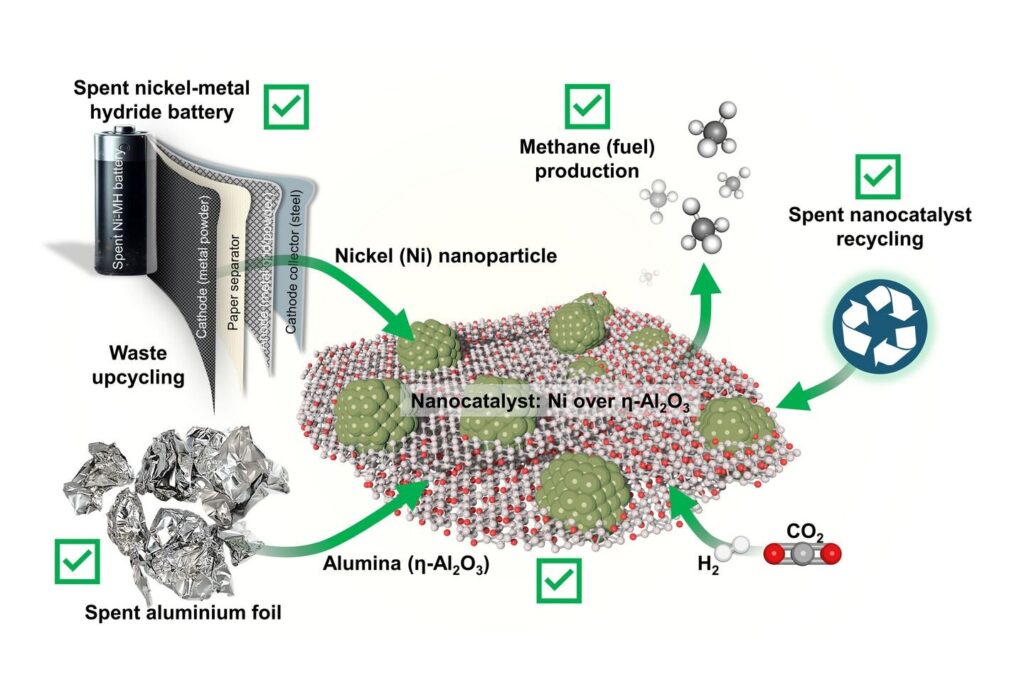Battery waste is a serious environmental problem: It contains substances that pose a threat to both human health and ecosystems. At the same time, however, batteries also contain valuable materials such as nickel, which we need—for example, for the production of new batteries. Better recycling methods for batteries are therefore urgently required.
At TU Wien, researchers have developed a process that can be used to recover nickel from spent nickel-metal hydride batteries. But that’s not all: from this battery waste and used aluminum foil, such as that used in the kitchen, it was possible to produce a nanocatalyst that converts CO2 into valuable methane. In this way, one can reduce the waste problem on the one hand and at the same time obtain a climate-neutral fuel.
Their paper is published in the journal Green Chemistry.
Battery recycling: Important for the environment and economy
“Modern batteries, such as nickel-metal hydride (Ni-MH) and lithium-ion batteries, consist of different components, which makes recycling and recovery processes technologically challenging,” says Prof. Günther Rupprechter from the Institute of Materials Chemistry at TU Wien, head of the research project. “Improper disposal can lead to chemical leaks, fires, and pollution.”
The recovery of nickel from spent Ni-MH batteries is also highly important economically: In the EU, waste batteries and scrap from battery production could provide around 16% of the nickel needed by 2030, which is enough to equip 1.3 to 2.4 million electric vehicles (EVs) annually.
Despite this potential, current recycling capacity in the EU and the UK is only about one-tenth of what is needed by 2030. Investments in recycling infrastructure are therefore necessary.
Upcycling: From waste recycling to CO2 capture
“Recycling is an important step, but even greater impact can be achieved by upcycling nickel into catalysts capable of producing fuels,” says Dr. Qaisar Maqbool, first author of the study.
The team extracted nickel from used Ni-MH batteries and recovered alumina from used aluminum foil. These materials were then converted into a high-performance nanocatalyst in an environmentally friendly way—using green chemistry methods.
“Our nanocatalyst consists of 92%–96% aluminum oxide and 4%–8% nickel, which is optimal for converting the greenhouse gas CO2 together with hydrogen into methane,” explains Günther Rupprechter. The process requires neither high pressure nor high temperatures; the catalyst works at atmospheric pressure and an easily achievable temperature of 250°C.
From greenhouse gas to clean energy
This provides a method for converting CO2 into a valuable fuel in a climate-neutral way: Methane plays an important role as an energy source in industry, for example. “Now we want to investigate how this process can be scaled up for technological applications,” says Prof. Günther Rupprechter.
“We believe that this approach can transform sustainable fuel production. Our approach shows a solution to the climate problem—and in a way that also helps to solve a pressing waste problem.”
Upcycled material can also be recycled
Many catalysts deactivate over time—because the catalyst changes structurally at some point or becomes less effective due to the accumulation of coke (carbon). Such a deactivation was not detected in the study. Nevertheless, it was important to the team to think in closed cycles and to consider how the catalyst itself can also be recycled.
“To close the sustainability loop, you can recycle the spent catalysts back into their original precursors to be reused,” says Dr. Qaisar Maqbool. This ensures that the entire process remains environmentally friendly, and the amount of waste is minimized.


